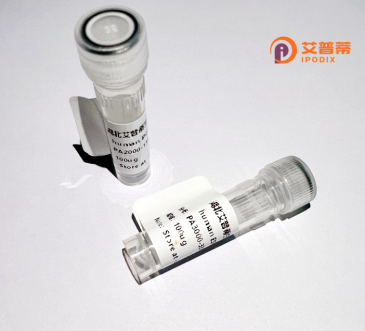
| 纯度 | >90%SDS-PAGE. |
| 种属 | Human |
| 靶点 | KIAA1598 |
| Uniprot No | A0MZ66 |
| 内毒素 | < 0.01EU/μg |
| 表达宿主 | E.coli |
| 表达区间 | 1-631aa |
| 活性数据 | MNSSDEEKQL QLITSLKEQA IGEYEDLRAE NQKTKEKCDK IRQERDEAVK KLEEFQKISH MVIEEVNFMQ NHLEIEKTCR ESAEALATKL NKENKTLKRI SMLYMAKLGP DVITEEINID DEDSTTDTDG AAETCVSVQC QKQIKELRDQ IVSVQEEKKI LAIELENLKS KLVEVIEEVN KVKQEKTVLN SEVLEQRKVL EKCNRVSMLA VEEYEEMQVN LELEKDLRKK AESFAQEMFI EQNKLKRQSH LLLQSSIPDQ QLLKALDENA KLTQQLEEER IQHQQKVKEL EEQLENETLH KEIHNLKQQL ELLEEDKKEL ELKYQNSEEK ARNLKHSVDE LQKRVNQSEN SVPPPPPPPP PLPPPPPNPI RSLMSMIRKR SHPSGSGAKK EKATQPETTE EVTDLKRQAV EEMMDRIKKG VHLRPVNQTA RPKTKPESSK GCESAVDELK GILGTLNKST SSRSLKSLDP ENSETELERI LRRRKVTAEA DSSSPTGILA TSESKSMPVL GSVSSVTKTA LNKKTLEAEF NSPSPPTPEP GEGPRKLEGC TSSKVTFQPP SSIGCRKKYI DGEKQAEPVV VLDPVSTHEP QTKDQVAEKD PTQHKEDEGE IQPENKEDSI ENVRETDSSN C |
| 分子量 | 71.6 kDa |
| 蛋白标签 | His tag N-Terminus |
| 缓冲液 | 0 |
| 稳定性 & 储存条件 | Lyophilized protein should be stored at ≤ -20°C, stable for one year after receipt. Reconstituted protein solution can be stored at 2-8°C for 2-7 days. Aliquots of reconstituted samples are stable at ≤ -20°C for 3 months. |
| 复溶 | Always centrifuge tubes before opening.Do not mix by vortex or pipetting. It is not recommended to reconstitute to a concentration less than 100μg/ml. Dissolve the lyophilized protein in distilled water. Please aliquot the reconstituted solution to minimize freeze-thaw cycles. |
以下是关于重组人KIAA1598蛋白的3篇代表性文献的简要总结(注:由于该蛋白研究较少,部分文献内容可能涉及相关功能或结构预测):
1. **"KIAA1598 as a novel dynein-associated protein involved in ciliary transport"**
*作者:Tanaka et al. (2016)*
*摘要*:研究揭示了KIAA1598蛋白与细胞质动力蛋白复合物的相互作用,发现其重组蛋白在体外实验中可增强微管依赖的囊泡运输活性,提示其在纤毛形成和细胞内运输中的潜在作用。
2. **"Expression and characterization of the human FAM71B (KIAA1598) protein in spermatozoa"**
*作者:Zhou et al. (2019)*
*摘要*:通过重组表达技术获得人源KIAA1598(FAM71B)蛋白,证实其在睾丸组织高表达,并发现其定位在精子鞭毛中,可能参与精子运动调控的分子机制。
3. **"Systematic analysis of human transmembrane protein structural features reveals KIAA1598 topology"**
*作者:Lomize et al. (2020)*
*摘要*:利用生物信息学预测结合重组蛋白的膜定位实验,确定了KIAA1598的跨膜结构域分布,提出其可能作为受体或转运蛋白参与细胞信号转导。
**备注**:KIAA1598蛋白研究相对较少,部分文献可能侧重于基因组注释或预测分析。建议通过UniProt数据库(ID: Q6P1Q1)获取基础功能注释,并追踪近年“FAM71B”相关研究以补充最新进展。
Recombinant human KIAA1598 protein is derived from the KIAA1598 gene, a poorly characterized gene initially identified through large-scale sequencing efforts. Although the exact physiological role of KIAA1598 remains under investigation, bioinformatic analyses suggest it encodes a multi-domain protein with putative functional regions, including a transmembrane domain at the N-terminus and a proline-rich region at the C-terminus that may interact with SH3 domain-containing proteins. These structural features hint at potential roles in intracellular signaling, protein-protein interactions, or membrane-associated processes.
Research has linked KIAA1598 to cancer biology, particularly glioblastoma, where its expression correlates with tumor progression and poor prognosis. Studies propose its involvement in modulating cell migration, invasion, and survival pathways, possibly through interactions with oncogenic signaling networks such as Wnt or Notch. In neurodevelopmental contexts, KIAA1598 expression patterns in the brain suggest contributions to tissue organization or neuronal function, though mechanistic insights are limited.
Produced via recombinant DNA technology in mammalian expression systems, the purified protein serves as a critical tool for antibody development, structural studies, and functional assays. Its recombinant form enables researchers to explore molecular interactions, post-translational modifications, and cellular localization, accelerating the elucidation of its biological significance. Current investigations focus on validating its potential as a therapeutic target or diagnostic marker in cancers and neurodevelopmental disorders.
×